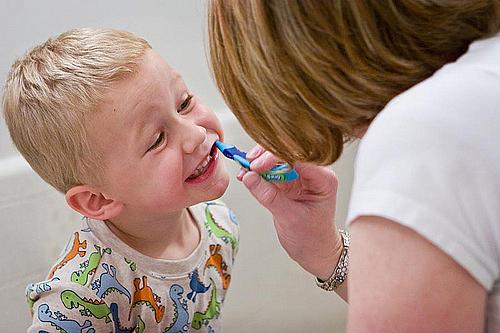Taking Dentistry to the Patients Who Need It Most

In my last post I looked at California’s poor track record when it comes to low-income kids’ dental care, and how missed dental visits can lead to missed school days, unnecessary visits to the E.R., and countless instances of entirely preventable suffering.
California’s dismal Medicaid reimbursement rates are a big part of the problem (for example, a dentist is reimbursed $15 for a dental exam). Consequently, many dentists choose not to see kids on Denti-Cal, the state’s Medicaid fee-for-service dental program for children, with less than a quarter of the state’s dentists accepting Medicaid patients, according to 2010 figures.
The shortage of dentists accepting Medicaid is compounded by other problems: In rural areas, just getting to a dentist might be half the challenge. In other families, parents might not be able to get time off work, or they might not realize the importance of regular visits in the first place.
With some of these challenges in mind, a new approach is winding its way through the state legislature that attempts to make it easier to reach underserved kids (and adults) by putting dental care providers into schools, health clinics and community centers.
“There is a portion of children and adults who don’t visit the traditional dental office system, whether because there are no dentists in their community or because they face socio-economic barriers,” said Jenny Kattlove, director of Strategic Health Initiatives for The Children’s Partnership, a children’s advocacy nonprofit pushing for new legislation. “They just never go to the dentist, so it makes sense to bring the dentist to them.”
The “virtual dental home” concept, based on a pilot program led by the Pacific Center for Special Care at the University of the Pacific’s dentistry school, gives specially trained dental hygienists and assistants expanded powers to do things such as decide on which x-rays to take or complete temporary fillings on their own.
With their portable dental chair, laptop, digital camera and handheld x-ray machine, such assistants can go into an elementary school or community center and immediately start seeing patients. Images and records can then be sent back to a supervising dentist instantaneously via a secure Web server, and the dentist then responds with a specific treatment plan. These on-site hygienists and assistants can handle basic procedures, and for more complicated problems, an appointment will be made then and there for the patient to follow-up up with a nearby dentist.
California’s Assembly Bill 1174 proposes a few changes to state law that would allow the virtual dental home concept to be implemented beyond the pilot-project stage. The bill, backed by state Assemblyman Raul Bocanegra (D-Pacoima), gives registered dental hygienists and assistants the power to carry out imaging and treatment of patients on their own. It also requires Medi-Cal, the state’s Medicaid program, to reimburse dentists who participate in such forms of remote “teledentistry.”
On Jan. 27, the legislation passed the state assembly and is now headed to the state Senate.
Proponents of the legislation say that employing hygienists and assistants to do imaging and routine care “in the field,” so to speak, is more cost-effective and efficient than the traditional model of in-office visits. And the program has the crucial benefit of reaching patients who might not otherwise make it to dentist office until the problem grows unbearable.
“Kids are getting care they would’ve never gotten before,” Kattlove said.
Adults now stand to benefit, too. California’s Denti-Cal program covered basic dental care for adults until state budget cuts in 2009 narrowed the dental benefits to kids. But the dental benefits for adults are set to be restored starting May 1, extending coverage to an estimated 3 million more low-income Californians.
But those newly covered dental patients will place an even greater strain on the already extremely short supply of dentists willing to take Denti-Cal patients. New models such as the Virtual Dental Home could help ease such shortages and make it easier for millions of newly covered Californians – kids and adults alike – to get basic care for their teeth after years of neglect.
Image by makelessnoise via Flickr
